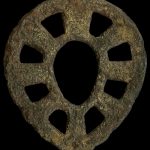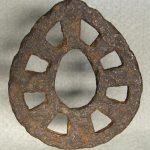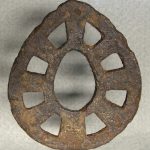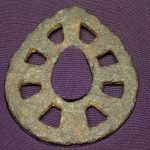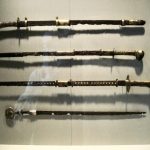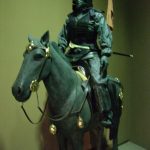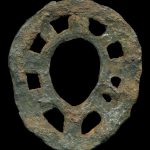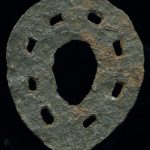TSUBA / TORAN KEI / KOFUN PERIOD / c. 500 Ad.
Toran Kei Tsuba
倒卵形
This style of tsuba is known a Toran Kei (Toran meaning egg shaped) and are some of the earliest known works of Japanese tsubako. The eight trapezoidal sukashi cut into the plate are a typical design seen on this style of tsuba.
This tsuba was made from unfolded coarse, but relatively soft iron. The plate is heavy and quite uniform in thickness, showing a minimal amount of deterioration. Most of these examples were excavated from ancient burial grounds during the Kofun period (c. 6th century), making this tsuba around 1500 years old.
The first time I held this tsuba I was surprised by it’s weight and it’s size of 9.7 x 8.5 x 0.5 cm. As well, the nakago ana seemed huge at 3.81 x 2.54 cm, however as I was to discover, these tsuba did not fit directly over the nakago as seen on later swords, but actually fit over a collar in front of the tsuka, hence the large diameter.
These tsuba were made for the style of sword known as Chukoto or straight sword. These early swords were a long (36″+), straight, triangular or wedge-shaped blade which predates the curved Japanese sword as we know it today.
Exhibited in the “Samurai” exhibit held at the Frazier Museum in Louisville, Kentucky 2012.
Kofun Period, ca. 500AD
Tsuba 9.7 x 8.5 x 0.5 cm
Nakago Ana 3.81 x 2.54 cm
A few years ago this tsuba was discussed at length. I have included the discussion in the event some may be interested.
TORAN KEI
To put this tsuba into a historical and quality perspective, I have added a number of images below. These include a collection of chokuto swords which utilized similar tsuba from the Metropolitan Museum, as well as images from the Inariyama Kofun Museum, Saitama for a mounted warrior of the period, wearing this type of chokuto (the proto-samurai) – image is a bit blurry. What is interesting, is that most of swords of this type preserved in museums utilize bronze gilded toran kei tsuba, while this is obviously iron. Perhaps the iron pieces were for field use, or were used by a certain rank / economic status soldier. I have owned half dozen such tsuba over the years, but Ed’s is the best quality iron tsuba I have seen since the late 90’s (the better one went at auction for ~$12k, but was virtually uncorroded and had unique, angled sukashi). Most are thinner, far less robust and a little smaller. I am adding two pix of others I have recently owned (one was inlaid with silver on the edge).
*See the additional photos referred to in the first paragraph in the photo gallery below.
As a point of observation, there was unsurprisingly a wide variety of quality among tosogu during the Kofun. Some iron tsuba I have owned were dense, thin and likely laminated (folded) construction (as were blades and armors by this period). Others were softer, with no apparent lamination and a very course, grainy iron composition. I will leave this debate/explanation to others.
We never stop to think what came before the Kamakura/Heian in terms of armor, swords etc… Samurai didnt just pop into existence one bright sunny day — it was a LONG process, and the technology, aesthetics that we see reflected in these tosogu and armor are purely Japanese. Also, from a historical perspective, what we fail to appreciate is the importance of Yamato Japanese as a regional military and economic power… Japan was a net exporter of military hardware at this time, as well as a leading naval power. This should make this period very interesting from a nihonto point of view and from a technologic and artistic perspective. Look at the dude on the horse… there is very little difference between this ca. 600AD image, and our image of the samurai of the Gempei no Ran. In fact, the epic battles between the Soga, Mononobe and Nakatomi clans were directly comparable, if not larger in scale than the Gempei wars, as they spilled overseas into Korea. The Fujiwara, Minamoto, Taira and host of other familiar clans trace lineage to these great Kofun / Asuka clans. Just read the Kojiki and Nihon Shoki for a window into the complexity of the Kofun/Asuka. Medieval Japan as we know it blossomed out of this period. The issue of course, is that access to such old items of tosogu / armor is very limited to most collectors.
-BM
No nod to China?
-CB
There was a reasonable amount of cross-influence in this period, and the roots of most things are ultimately traced back to China in these early centuries. ie. lamellar armor is generally attributed to China, as are chokuto, but we don’t over-extend this influence. Its important to acknowledge that what we see in the Kofun period actually has virtually no direct Chinese influence. Korean influence is clear in the mid-Kofun, but by the late Kofun, its actually the Japanese that are driving the technology and aesthetics…. this fact that is poorly recognized unfortunately. This is a great discussion topic, with suprisingly a large amount of available data — a really good separate thread I think.
-BM
I wonder if to call the mounted warrior in the picture a samurai is in fact correct. I think the term samurai was not coined until around the Heian period in the Kokin Waka Shu (古今和歌集, Collection of Poems of Ancient and Modern Times) which dates from around 900s. I think the photoed warrior pre-dates the Heian period by a few centuries and if so, he was probably nobility or an enlisted warrior for the then national military or “Gundan-Sei” (軍団制) serving the emperor.
-HW
Yes, samurai is a anachronistic for this period, as you correctly pointed out. This was before the Taiho Ritsuryo, so the various offices and titles we see from the Nara period onwards such as Imperial Guards had not yet been created. The figure on horseback could best be considered a military elite, perhaps a ranking member of some uji (clan), or military commander working for the provincial governors (Gunshi), or Yemishi commander. I used to have good translated copies of both Kojiki and Nihon Shoki in university, but those texts have been misplaced decades ago. If you do find them either online as John suggests, or through a university bookstore, try to get the unabridged versions, with scholarly discussions on each section to help contextualize the content. They are actually very dull reading as I recall, if you dont have the benefit of such historical analysis.
Anyhoooo, this was a good thread, thanks Ed. Love that tsuba — top-notch example of an iron toran-kei tsuba.
-BM
